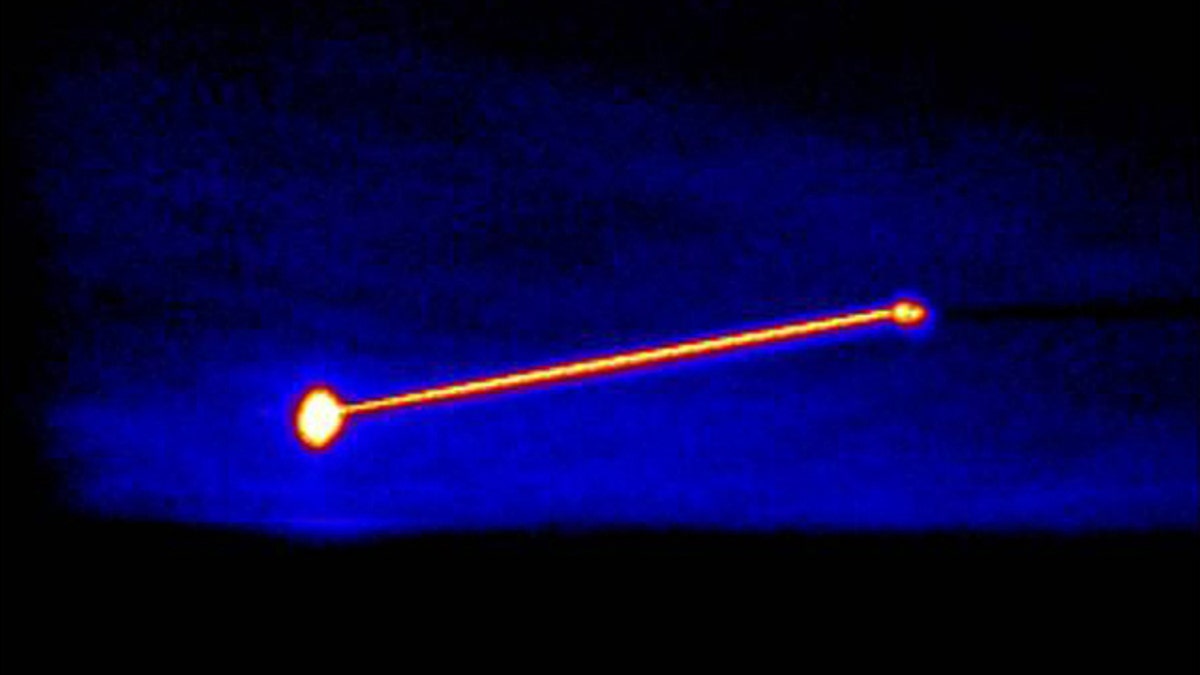
An infrared image of the Missile Defense Agency’s Airborne Laser Testbed (right) destroying a threat representative short-range ballistic missile (left). (Missile Defense Agency)
Laser weapons aren't just the realm of science fiction. The military just completed the first airborne test of a futuristic energy weapon, simulating defense against a missile attack. This could be the answer to a rapidly arming Iran -- if the government can afford it.
In the test, a modified Boeing 747 jet took off from Edwards Air Force Base carrying a Northrop Grumman designed laser in its nose. The plane used built-in infrared sensors to find and destroy an in-flight missile.
A joint venture between Boeing and the U.S. Missile Defense Agency, the tests mark the first time a laser weapon has engaged and destroyed an in-flight ballistic missile, and the first time any system has accomplished it in the missile's "boost" phase of flight. It was also the highest-energy laser ever fired from an aircraft -- and the most powerful mobile laser in the world.
The military hopes a slew of these and other laser weapons will underpin its next-generation military force. The army recently tested a truck-mounted laser weapon designed to counter artillery, mortar, drone aircraft and even rockets. Airborne ray guns such as those in the newest test are intended to deter enemy missile attacks and provide the U.S. military with the ability to engage all classes of ballistic missiles at the speed of light.
"The revolutionary use of directed energy is very attractive for missile defense, with the potential to attack multiple targets at the speed of light, at a range of hundreds of miles, and at a low cost per intercept attempt compared to current technologies," the U.S. Missile Defense Agency noted after the test.
Military contractors all argue that as rogue nations like Iran develop new missiles, such systems will become more important.
The 2011 budget for the Missile Defense Agency concentrates on two ship-based missiles -- the Aegis and the SM-3 -- that are more useful for regional conflicts involving, say, Iran or North Korea, Mcaleese said.
"Having the capability to precisely project force, in a measured way, at the speed of light, will save lives," said Michael Rinn, Boeing vice president and ALTB program director. Northrop Grumman agrees, noting that "while ballistic missiles like the one ALTB destroyed move at speeds of about 4,000 miles per hour, they are no match for a superheated, high-energy laser beam racing towards it at 670 million mph."
Lasers have certainly been a focus of army research for decades, and it's still a stated aim of the U.S. government to deploy a National Missile Defense system as soon as possible. But budget woes and setbacks have delayed the program, which at this point may never arrive.
"This was supposed to put high-powered lasers on a fleet of 747s," Secretary of Defense Robert Gates said in a speech last year. "After more than a decade of research and development, we have yet to achieve a laser with enough power to knock down a missile in boost phase more than 50 miles from the launch pad -- thus requiring these huge planes to loiter deep in enemy air space to have a feasible shot at a direct hit."
As a practical matter, absent something extraordinary, the program has already receded backwards into a technology incubator as opposed to proceeding into production and fielding," he said.
The Associated Press contributed to this report.
